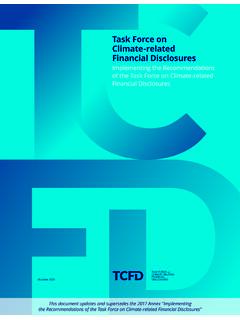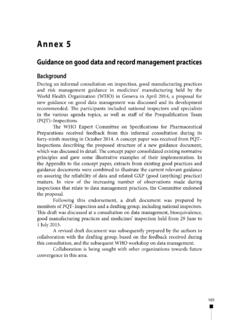Transcription of Annex 2 WHO good practices for pharmaceutical …
1 69 World Health OrganizationWHO Technical Report Series, No. 961, 2011 Annex 2 WHO good practices for pharmaceutical microbiology laboratoriesBackgroundThe WHO Expert Committee on Specifi cations for pharmaceutical Preparations adopted in 2009 a revised version of the Good practices for pharmaceutical quality control laboratories (1).During the inspections carried out when prequalifying laboratories , the inspectors had noticed that some of the texts of these guidelines might benefi t from additional guidance, with a special focus on light of the above, the Expert Committee recommended that the WHO Secretariat initiate the process of developing a new text on good practices for pharmaceutical microbiology following text is proposed to cover this specifi c type of and scope of documentGlossary 1.
2 Personnel 2. Premises Environmental monitoring in the laboratory Cleaning, disinfection and hygiene Sterility test facilities 3. Validation of test methods 4. Maintenance of equipment Qualifi cation Calibration, performance verifi cation and monitoring of use 5. Reagents and culture Reagents Media Labelling Organism resuscitation70 6. Reference materials and reference International standards and pharmacopoeial reference Reference cultures 7. Sampling 8. Sample handling and identifi cation 9. Disposal of contaminated waste10. Quality assurance of results and quality control of Internal quality control11. Testing procedures12.
3 Test reportsReferencesFurther readingAppendix 1 Examples of zones in which operations could be carried outAppendix 2 Examples of maintenance of equipmentAppendix 3 Examples of calibration checks and intervals for different laboratory equipmentAppendix 4 Examples of equipment qualifi cation and monitoringAppendix 5 General use of reference cultures71 Introduction and scope of documentPharmaceutical microbiology laboratories may be involved in: sterility testing; detection, isolation, enumeration and identifi cation of microorganisms (bacteria, yeast and moulds) and testing for bacterial endotoxins in different materials ( starting materials, water), products, surfaces, garments and the environment; and assay using microorganisms as part of the test guidelines relate to all microbiology laboratories involved in the above-mentioned testing activities, whether they are independent or a department or unit of a pharmaceutical manufacturing guidelines are based on and supplement the requirements described in Good practices for pharmaceutical quality control laboratories (1);General guidelines for the establishment, maintenance and distribution of chemical reference substances.
4 Revision (2);The International Pharmacopoeia,Fourth Edition (3); First Supplement to The International Pharmacopoeia,Fourth Edition (4); and ISO/IEC 17025 (5). GlossarycalibrationThe set of operations that establish, under specifi ed conditions, the relationship between values indicated by an instrument or system for measuring (especially weighing), recording and controlling, or the values represented by a material measure, and the corresponding known values of a reference standard. Limits for acceptance of the results of measuring should be ed reference materialReference material, characterized by a metrologically valid procedure for one or more specifi ed properties, accompanied by a certifi cate that provides the value of the specifi ed property, its associated uncertainty and a statement of metrological of detectionThe lowest number of microorganisms that can be detected, but in numbers that cannot be estimated degree of agreement among individual limit (limit of quantitation)Applied to quantitative microbiological tests.
5 The lowest number of microorganisms within a defi ned variability that may be counted under the experimental conditions of the method under culturesCollective term for reference strain and reference materialMaterial suffi ciently homogeneous and stable with respect to one or more specifi ed properties, which has been established to be fi t for its intended use in a measurement methodA method which has been validated as being fi t for purpose, with which an alternative method may be stocksA set of separate identical cultures obtained by a single subculture from the reference strain (6).reference strainsMicroorganisms defi ned at least to the genus and species level, catalogued and described according to its characteristics and preferably stating its origin (6).Normally obtained from a recognized national or international of the agreement between the results of successive measurements of the same measure and under the same conditions of measurement (adapted from ISO).
6 ReproducibilityReproducibility expresses precision between (or ruggedness)The ability of the procedure to provide analytical results of acceptable accuracy and precision under a variety of fraction of the total number of positive cultures or colonies correctly assigned in the presumptive inspection (7).specifi city (selectivity)The ability of the method to detect the required range of microorganisms that might be present in the test of proving, in accordance with the principles of good practice quality guidelines and regulations (GxP), that any procedure, process, equipment (including the software or hardware used), material, activity or system actually and consistently leads to the expected cationThe application of methods, procedures, tests and other evaluations, in addition to monitoring, to determine compliance with GxP cultureA primary subculture from a reference stock (6).
7 1. Microbiological testing should be performed and supervised by an experienced person, qualifi ed in microbiology or equivalent. Staff should have basic training in microbiology and relevant practical experience before being allowed to perform work covered by the scope of Current job descriptions for all personnel involved in tests and/or calibrations, validations and verifi cations should be maintained. The laboratory should also maintain records of all technical personnel, describing their qualifi cations, training and the laboratory includes opinions and interpretations of test results in reports, this should be done by authorized personnel with suitable experience and relevant knowledge of the specifi c application including, for example, regulatory and technological requirements and acceptability The laboratory management should ensure that all personnel have received adequate training for the competent performance of tests and operation of equipment.
8 This should include training in basic techniques, plate pouring, counting of colonies, aseptic technique, media preparation, serial dilutions, and basic techniques in identifi cation, with acceptability determined using objective criteria where relevant. Personnel may only perform tests on samples if they are either recognized as competent to do so, or if they do so under adequate supervision. Competence should be monitored continuously with provision for retraining where necessary. Where a method or technique is not in regular use, the competency of the personnel to perform the test should be verifi ed before testing is undertaken. In some cases it is acceptable to relate competence to a general technique or instrument being used rather than to particular Personnel should be trained in necessary procedures for containment of microorganisms within the laboratory Personnel should be trained in safe handling of microbiology laboratories and certain support equipment ( autoclaves and glassware) should be dedicated and separated from other areas, especially from production microbiology laboratories should be designed to suit the operations to be carried out in them.
9 There should be suffi cient space for all activities to avoid mix ups, contamination and cross-contamination. There should be adequate suitable space for samples, reference organisms, media (if necessary, with cooling), testing and records. Due to the nature of some materials ( sterile media versus reference organisms or incubated cultures), separate storage locations may be laboratories should be appropriately designed and should take into account the suitability of construction materials to enable appropriate cleaning, disinfection and minimize the risks of There should be separate air supply to laboratories and production areas. Separate air-handling units and other provisions, including temperature and humidity controls where required, should be in place for microbiological laboratories .
10 The air supplied to the laboratory should be of appropriate quality and should not be a source of Access to the microbiological laboratory should be restricted to authorized personnel. Personnel should be made aware of: the appropriate entry and exit procedures including gowning; the intended use of a particular area; the restrictions imposed on working within such areas; the reasons for imposing such restrictions; and the appropriate containment Laboratory activities, such as sample preparation, media and equipment preparation and enumeration of microorganisms, should be segregated by space or at least in time, so as to minimize risks of cross-contamination, false-positive results and false-negative results. Where non-dedicated areas are used, risk management principles should be applied.

















